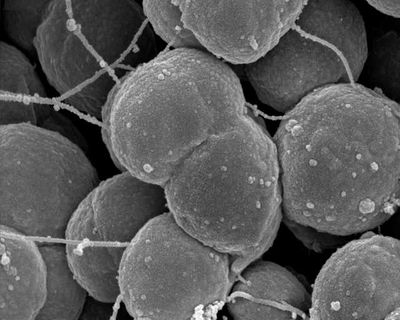Natronococcus roseus
Classification & Phylogeny

Domain: Archaea
Kingdom: Euryarchaeota
Phylum: Euryarchaeota
Class: Halobacteria
Order: Halobacteriales
Family: Halobacteriaceae
Genus: Natronococcus
Species: Natronococcus roseus
Natronococcus roseus is closely related to Natronococcus amylolyticus, Natronococcus jeotgali, & Natronococcus occultus, sharing 98.4%, 96.2%, and 95.7% 16S rRNA sequence respectively. This relationship is shown in the phylogenetic tree.[1][4]
Description & Significance

The bacterium was isolated from Lake Chagannor in Inner Mongolia, China. The colonies were pink with color intensity that decreased when the cells grew at salt saturation levels.[1][4]
The bacterium was found in irregular clusters, pairs, and single cells. N. roseus is non-motile, cocci, gram-variable, obligate aerobe, and reduces nitrate to nitrite. Optimal growth range is between 8% and 30% NaCl, at a pH range of 8.5-11 (prefers 9.5), and a temperature range of 20-50°C (optimum at 40 °C).[1][4]
Notably the lack of the phospholipid, PL2, sets it apart from it's relative Natronococcus occultus. It's lipids contain derivatives of phosphatidylglycerol (PG), phosphatidylglycerol phosphate methyl ester (PGP-Me) and minor phospholipid components. No glycolipids were found. [1][4]
The bacterium is susceptible to novobiocin (10 µg), bacitracin (10 µg), anisomycin (5 µg), erythromycin (15 µg) and streptomycin (10 µg); resistant to rifampicin (5 µg), ampicillin (10 µg), neomycin (30 µg), chloramphenicol (30 µg) and nalidixic acid (30 µg).[1][4]
Metabolism
Natronococcus uses glucose, lactose, sucrose, d-fructose, maltose, d-mannitol, sorbitol, glutamate, acetate, lactate, propionate, pyruvate, and succinate. For carbon and energy however, it does not use galacose, sobose, arabinose, and rhamnose. The bacterium uses the amino acids serine, threonine, glycine, asparagine and lysine. Natronococcus reduces nitrate to nitrite as is common amongst halophiles.[1][4]
Genomic Content
The strain has a G+C content ratio of 62.1 mol%, while the minor component has a content of 55.7 mol%. The value falls within range for the Natronococcus genus.[1][4]
Reproduction
Natronococcus roseus like all archaea reproduces asexually through binary fission.[3]
Ecology
Natronococcus roseus is a chemooganotrophic bacterium thus far only isolated from Lake Chagannor, a hypersaline lake. [1]
References
(1.) Corral P, Gutierrez MC, Castillo AM, Dominguez M, Lopalco P, Corcelli A, Ventosa A. 2013. Natronococcus roseus sp nov., a haloalkaliphilic archaeon from a hypersaline lake. International Journal of Systematic and Evolutionary Microbiology 63:104-108.
(2.) H.N.M.Ross 2012, posting date. Electron micrograph of Natronococcus occultus. [Online.]
(3.) Krieg N. 2005. p. 21-22, Bergey's Manual of Systematic Bacteriology. US: Springer.
(4.) Tindall BJ, Ross HNM, Grant WD. 1984. NATRONOBACTERIUM GEN-NOV AND NATRONOCOCCUS GEN-NOV, 2 NEW GENERA OF HALOALKALIPHILIC ARCHAEBACTERIA. Systematic and Applied Microbiology 5:41-57.
